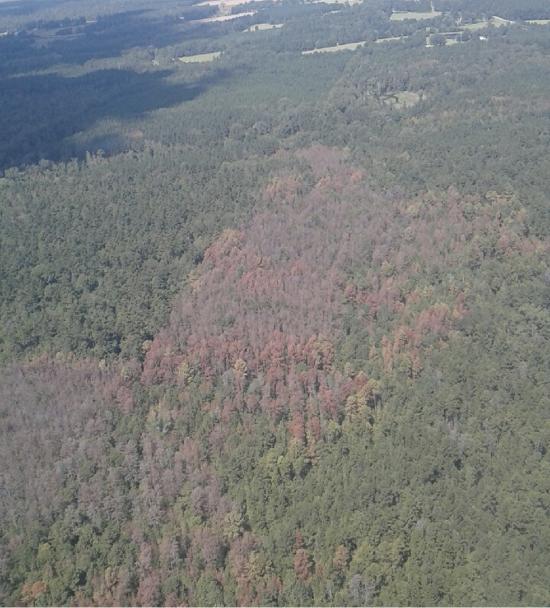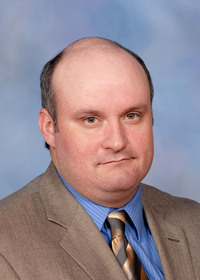Southern Pine Beetle in Mississippi: An Overview
The scientific name for the southern pine beetle (SPB) is Dendroctonus frontalis Zimm, meaning “tree killer.” The SBP has been just that in Mississippi for thousands of years (Figure 1). At low population levels, SPB will attack stressed, damaged, or overly stocked stands. However, at high populations of an outbreak, SPB will attack healthy and vigorous pine trees, killing trees regardless of age, health, or condition until they run out of pines. Many landowners have suffered losses, ranging from a few trees to entire stands.

Inadequate monitoring and failure to control known infestations can result in loss of valuable stands of pine timber. Producers lose money when they have to prematurely harvest during poor market conditions to avoid loss to the SPB. With proper monitoring and control efforts, losses should be less than 10 percent of the stand over the course of an epidemic period. A few landowners will have large losses, but these are usually cases where infestations have been undetected or ignored. Producers must react to the SPB, but overreacting could decrease economic returns from the timber stand. It is important to recognize the SPB, to know what control tactics are available, and to make an informed decision concerning this pest if you have an infestation on your property.
SPB Biology
Pine trees are killed by adult beetles and their larvae. Female SPB begin attacking a tree by boring through the bark. They then lay small white eggs on the side of their tunnels (galleries) as they bore through the bark. Males follow, moving frass (excrement and dust) and packing it behind the pair as they move through the galleries. Winding S-shaped galleries, which may cross one another, are created in the infested portion of the bark (Figure 2). The infested portion of the bole can occur from near the ground to the first live limb; however, the SPB typically focus on the mid-bole of the tree.

After gallery construction is complete and eggs are laid, adults either die, “overwinter” in galleries, or bore out through the bark to attack again if environmental conditions are favorable. The tree is killed by a combination of girdling due to gallery construction and introduction of blue stain fungi, which block water transport.
Eggs hatch and larvae bore through the inner bark away from the adults’ galleries (Figure 3). The white grub-looking larvae grow larger as they move, until they are approximately one-eighth of an inch long. When mature, larvae bore into the outer bark and begin to change into pupae (Figure 4). The pupae are very soft and white with visible eye patches and premature wings.


After pupation, newly formed adults bore their way out of the bark. These adults fly to other trees in the vicinity, or fly some distance away to create a new infestation. The distance an adult can fly depends on its health and weather conditions at the time.
Beetles overwinter in all stages of development. Anytime the temperature rises above 55°F, eggs, larvae, and pupae can continue to develop, and overwintering adults can emerge to attack new trees. There can be as many as seven generations a year, depending on climatic conditions. SPB populations tend to go through cycles. Periods between epidemics (large beetle populations) vary from three to 15 years, with most epidemics lasting three to five years. It has not been determined why the population fluctuates in this manner, nor is it possible to accurately determine when the numbers will go up or down.
Recognizing SPB Infestations
It is important to be able to recognize both active and inactive trees. Active trees are those currently under attack by the SPB and can be identified by fading crowns and pitch tubes coming out of the bark (Figure 5). Inactive trees are those that are no longer under attack by SPB. Inactive trees have fully reddened/browned needles or a total lack of needles, and the bark is loose.

Later in spring, fading trees are usually the first noticeable symptom of an SPB attack (Figure 6). As trees die, their needles turn yellow and then red before they falling off. This characteristic is used to find active SPB infestations with aerial surveillance. The Mississippi Forestry Commission (MFC) conducts aerial surveillance on private lands; other organizations (U.S. Forest Service, wildlife management agencies, forest industry, or other large private or public landholders) do so on land for which they are responsible. You can find information on possible infestations on private land by contacting the MFC area forester for the county where the property is located or by contacting foresters with other organizations with land adjacent to your property.
Pitch tubes on the bark are another good indicator that your tree may be under attack by the SPB. Pitch tubes are formed when beetles enter a tree. They are the tree’s attempt to force (or “pitch”) the beetle out. They are dirty pinkish, yellowish, or white balls of resin that resemble popcorn and are about one-fourth to one-half of an inch in diameter.
The best way to identify the SPB is by the gallery patterns that can be seen under the bark. They have an “S”-shaped pattern with many adult gallery intersections. Larval galleries tend to be on alternate sides of the gallery, traveling perpendicular to parental galleries. Other bark beetles (e.g. Ips engraver beetles) tend to have straight, “H,” or “Y” shaped galleries. For more information on engraver beetles, please consult Mississippi State University Extension Publication 2876 Ips: The Other Pine Bark Beetles.
Controlling SPB Infestations
Several control techniques are available for SPB infestations. Market conditions, size and number of trees involved, and money available will help you decide what to do. Three basic categories of control are:
1. Salvage removal
2. Cut and leave
3. Pile and burn
Each of these tactics gives better results when applied as soon as possible after detection of an infestation. By treating early, fewer SPBs are allowed to develop and spread. Delaying treatment might allow an increase in the number of active trees to a level that makes control difficult.
In all cases, both attacked trees and a buffer of healthy, un-attacked trees at least as wide as one tree length (preferably two tree-lengths) around the spot need to be included in the control operation. If any infested trees are missed, or the buffer of healthy trees is not adequately treated, the infestation can resume resulting in further economic loss. Trees already killed by SPB (very red needles, grey or no needles, and very loose or no outer bark, usually at the center of an infestation) can be left behind, as natural enemies of the SPB will increase their populations on these trees. With any of the following control tactics, the area should be checked periodically after treatment for trees that were missed or for an outbreak around the treated area.

Salvage Removal
Often, trees involved in the infestation can be sold. This is obviously the preferable choice of the three basic control techniques. Even if only pulpwood is sold and the operation just breaks even, it is better than no return and the possibility of further economic losses. Another advantage is that beetles are removed with the trees. Often the market is flooded with beetle-killed wood during an epidemic, making it very difficult to salvage. Even during good markets, the price received will be considerably lower than for trees sold in a regular timber sale. It is expensive to move logging equipment and cut a logging road for the relatively low total volume of wood involved in most infestations. This becomes incredibly limiting in depressed timber markets.
Once an infestation is located, trees with active SPB should be marked with paint or flagging. Also, mark a buffer strip of green uninfested trees at the head of the infestation. This ensures removal of trees that might come under attack between the time they are marked and cut. The buffer strip should be 1 to 2 tree lengths wide, and it should extend, at a minimum, around the actively growing head of the spot. An even more conservative approach would be to mark a two-tree-length buffer around the entire spot. If the area involved is large enough, you can flag the outside edge to be cut instead of marking every tree.
Each tree must be examined carefully to determine if it contains beetles. You should consider a green tree infested if it has discolored needles, beetle entrance holes, brownish boring dust at the base (Figure 7), or spider webs on or near the bole and/or on the upper leaf surface of understory trees. Boring dust indicates that the tree is under attack. Since beetles usually start their attack near the middle of the bare bole (10 to 20 feet above the ground), pitch tubes may not be visible until the second or third day of an attack, but they are a sure sign of infestation.

After salvage, monitoring is extremely important to ensure that all infested trees were removed, and that the spot does not start to expand again.
Cut and Leave
This technique is the same as salvage removal except that the trees are not removed from the area. It is important to fell trees toward an infestation’s center, but it is also good to avoid creating a large woodpile that shades the infested bark (Figure 8). Direct sunlight on the bark can increase the temperature enough to kill beetles. Since higher temperatures play an important role in the success of this tactic, it is best employed during the summer months when temperatures average above 85°F.

This technique is used when market or other conditions will not allow salvage. It is the least expensive of the non-salvage techniques. The infestation is usually disrupted; however, some SPBs emerge from felled trees to move to other areas in the forest. Forcing beetles to fly greater distances should increase their natural mortality, which will also have an adverse effect on the SPB population. The cut and leave method will provide adequate control if properly applied, but is less preferred because trees are not taken to market.
Pile and Burn
This is probably the oldest of the control tactics. It is very effective when properly used. As the name implies, active trees are piled and burned, making sure the bark is charred thoroughly. There is greater liability since fire is involved. This control technique is used to prepare the site for tree planting, or to enhance wildlife habitat. Check burning conditions by contacting your MFC area forester, and do not set a fire without first obtaining a permit. It is important to avoid damaging or stressing residual live trees during this process.
Protecting High-Value Trees
Onyx Pro is a chemical SPB preventative, but is available only for ornamental pines. It is applied to the outside bark of trees, and kills beetles on contact for four to six months. Onyx is best used as a preventive method of controlling SPB infestations in high-value urban trees.
Onyx Pro is not capable of stopping beetles from killing an already heavily infested tree. Timing is critical when applying Onyx Pro on infested trees, and it is best used on uninfested trees next to those that are infested. Onyx Pro is not recommended for large areas with many infested trees.
You must treat the entire tree, coating the exterior surface from the top of the crown to the base of the tree. Onyx Pro is not absorbed by the tree, so it will not kill beetles underneath the bark. If beetles inside the tree, it will not kill them until they emerge as adults.
Onyx Pro is not water soluble, so precipitation will not change its effectiveness once dried on the tree. However, the active ingredient is toxic to aquatic animals, so it should not be allowed to contaminate surface runoff during application. Only commercial pesticide applicators may purchase and use Onyx Pro.
For yard trees, watering during summer months can also help prevent SPB attacks on high-value trees. In addition, using fertilizers can help maintain tree vigor and increase a tree’s ability to repel the SPB.
Reducing Loss with Timber Management
Maintaining a healthy pine stand is the best defense against the SPB. Densely-planted, slow-growing, or damaged trees are much more susceptible to attack. Thin stands to increase growth rate of selected crop trees. When pine stands need thinning (Figure 9), it is not recommended to delay thinning operation for better market conditions (Henderson and Londo, 2019). Harvest over-mature stands and replant. Conduct harvest operations in a manner that will protect the soil and remaining trees by following Mississippi Best Management Practices.

Tree vigor or overall health is indicated by radial growth. Unhealthy grow slower than healthy trees. Diseased, damaged, or crowded trees will not grow well. They attract SPBs and can become a focal point for a new infestation. Removing, or at least felling, these kinds of trees can lower susceptibility of the entire stand.
Reducing competition between trees is the best way to prevent losses from the SPB. Removing slower-growing trees through thinning allows residual trees to flourish. Remaining trees are in an environment less favorable for the SPB, continue to grow at a faster rate, and have more resistance to SPB attack because of higher resin production. This reduces the risk of attack, but, more importantly, places growth potential of the stand on remaining stems. Concentrating this growth on a lower number of residual trees greatly increases economic returns to the landowner because they can be harvested much earlier.
As timber gets older, growth of individual trees slows down. Stands that are biologically mature can become vulnerable to attack. Proper thinning can help extend health as the stand ages. If management decisions are based on economic returns, pine stands are harvested before age becomes a factor to SPB susceptibility. However, if older trees are being grown for aesthetic or other reasons, it is very important to watch closely during SPB epidemics and to remove infested trees as soon as possible.
Proper Response to SPB Infestations and Epidemics
Final harvests should be made only if market and timber conditions make it advantageous. Timber stands increase in value at a higher rate while entering sawtimber size than at any other time. Pulpwood-sized stands should not be clear-cut to avoid a potential loss to SPBs. Landowners should plan their final timber harvest by working with a registered forestry consultant.
Observations should increase during epidemic periods and control tactics used when possible. Do not ignore SPB infestations. If infestations occur, it is important to control each spot as quickly as possible to minimize the possibility of larger infestations forming. Areas with the most valuable timber should receive priority. Within these areas, infestations with the largest number of active trees should be controlled first. Smaller spots are easier to control, so early detection and prompt control efforts are key to minimizing losses.
Summary
Management of pine forests is influenced by many factors. The southern pine beetle is one of them. This pest can have devastating results on individual stands. Maintaining healthy trees, improving surveillance during epidemics, and controlling infestations as early as possible can minimize losses.
References
Henderson, J.E. & A.J. Londo. 2019. Publication 2732 Protect Your Pine Plantation Investment by Thinning. Mississippi State University Extension, 4p.
Self, A.B., J.D. Floyd, and J.J. Riggins. 2021. Ips: The Other Pine Bark Beetles. Mississippi State University Extension publication 2876. 4p.
More Information
For more information, contact your Mississippi Forestry Commission Area Forester, local Extension agent, or area Extension Forestry Specialist. In addition, the following links have more information on the SPB:
MSU Extension publications
http://extension.msstate.edu/publications
Southeastern Forest Insect Working Group
http://www.barkbeetles.org/spb/
USDA Forest Service SPB II Publication
https://www.srs.fs.usda.gov/pubs/39017
The University of Georgia Center for Invasive Species and Ecosystem Health
https://www.bugwood.org/index.cfm
The information given here is for educational purposes only. References to commercial products, trade names, or suppliers are made with the understanding that no endorsement is implied and that no discrimination against other products or suppliers is intended.
Publication 2748 (POD-03-22)
By Revised by Brady Self, Associate Extension Professor, Forestry, from a previous edition by Andrew Londo, PhD, former Extension/Research Professor, Forestry; John J. Riggins, PhD, Professor, Biochemistry, Molecular Biology, Entomology, and Plant Pathology; and Nathan S. Little, PhD, USDA APHIS, Entomology.
The Mississippi State University Extension Service is working to ensure all web content is accessible to all users. If you need assistance accessing any of our content, please email the webteam or call 662-325-2262.





